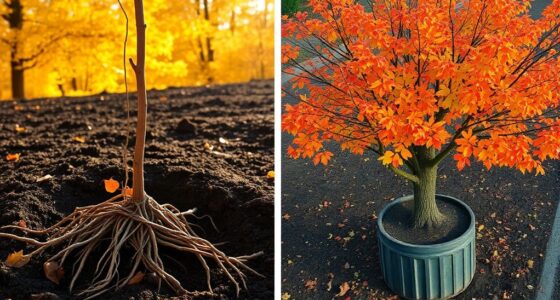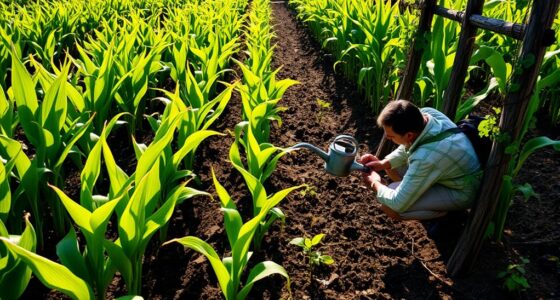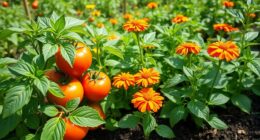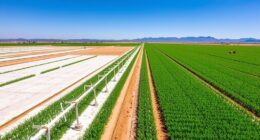To recognize shot-hole disease in stone fruits, look for small, round, sunken spots on leaves and fruit that eventually develop into holes, often with yellow or brown rings. Symptoms include early leaf spots, leaf drop, and damaged fruit. Managing it involves regular inspections, removing fallen debris, pruning for airflow, and applying organic or chemical fungicides early. Keep monitoring ongoing practices to protect your trees—more details can help you stay ahead of the disease.
Key Takeaways
- Identify shot-hole disease by small, sunken, tan or reddish spots on leaves that enlarge into holes.
- Monitor regularly during wet, humid conditions to catch early leaf spots and prevent spread.
- Use sanitation practices like removing fallen debris and infected fruit to reduce fungal sources.
- Apply organic copper fungicides or approved chemical treatments early at first signs for effective control.
- Prune to improve airflow, remove infected branches, and maintain tree health to minimize disease susceptibility.
Understanding Shot‑Hole Disease and Its Causes
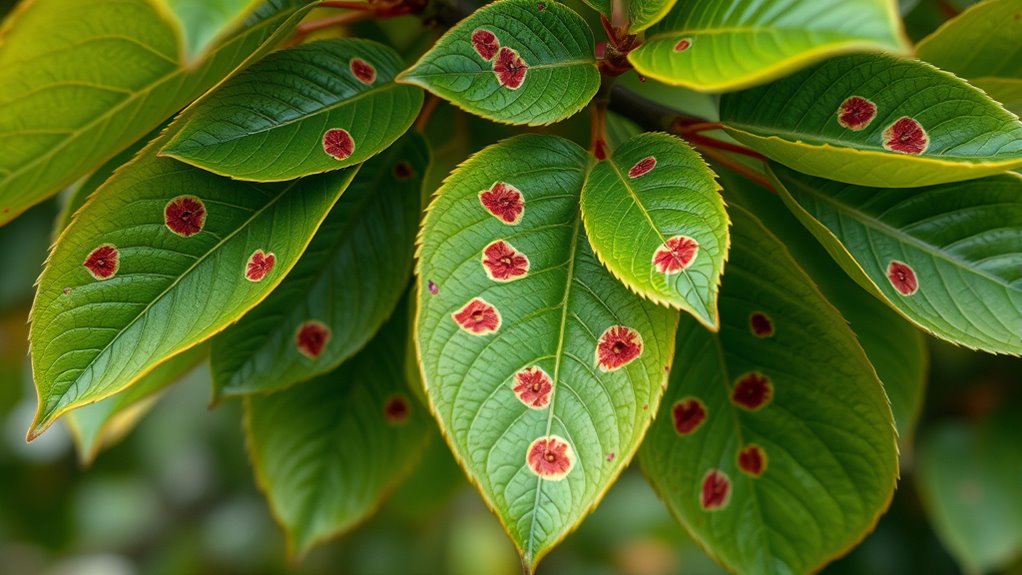
Shot-hole disease is a common fungal infection that affects stone fruits, causing small, round holes to appear on leaves and fruit surfaces. It’s caused by the fungus *Stigmina carpophila*, which thrives in moist, warm conditions. The disease often begins during wet weather or periods of high humidity, making orchards with poor air circulation more vulnerable. Spores spread easily through rain, wind, or contaminated tools, initiating new infections. Once the fungus infects the plant, it penetrates the tissue, disrupting normal growth and causing the characteristic holes. It’s important to understand that the disease can remain dormant in fallen leaves or infected plant debris, reactivating when conditions become favorable. Proper management starts with understanding the environmental factors that promote fungal growth and implementing effective control measures.
Common Symptoms and Visual Clues
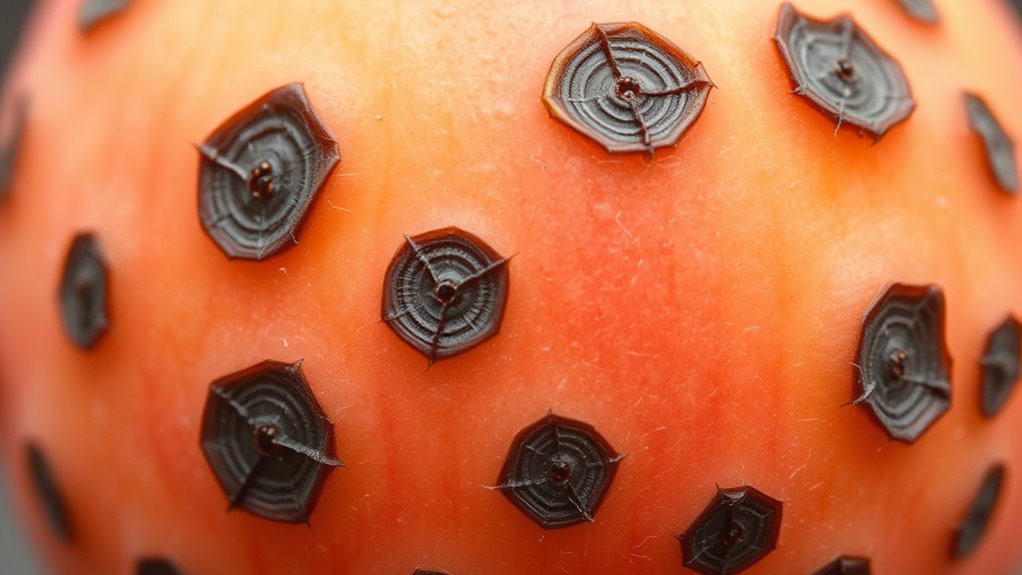
Once the fungus infects your stone fruits, you’ll notice distinctive signs on both leaves and fruit surfaces. On the leaves, small, round, sunken spots appear, often with a tan or reddish center surrounded by a darker halo. Over time, these spots may develop into holes, giving the leaves a “shot-hole” appearance. On the fruit, you’ll see similar round lesions, which can enlarge and sometimes crack open. These lesions may be surrounded by a yellow or brown ring. You might also notice early leaf drop or defoliation, especially during wet weather. The combination of these symptoms—small holes, spots, and fruit damage—serves as visual clues that shot-hole disease is affecting your trees. Recognizing these signs early helps you manage the disease effectively.
Identifying Early Signs of Infection

Keep a close eye on your trees for early signs of shot-hole disease, especially by spotting leaf spots that appear as small, dark areas. Monitor your fruit for any new lesions or irregularities that could indicate infection. Catching these initial changes early helps you manage the disease before it spreads extensively. Using protective styling benefits can also help reduce stress on the plant, making it less susceptible to infections.
Spotting Leaf Spots
Early detection of leaf spots is essential for managing shot-hole disease effectively. As you inspect your trees, look closely at the foliage for small, circular spots that may be tan, brown, or reddish. These spots often have darker margins and may develop concentric rings over time. You might notice some spots merging, creating larger areas of damaged tissue. Be alert for premature leaf drop or leaves that look mottled or discolored. Spotting these early signs allows you to act quickly before the infection spreads further. Regularly checking your trees, especially during wet weather, helps catch leaf spots early. Understanding the vibrational state of your trees can also aid in preventative practices by promoting overall plant health. Remember, the sooner you identify these symptoms, the better your chances of controlling the disease and protecting your stone fruit crop.
Monitoring Fruit Lesions
When inspecting your stone fruits, paying close attention to the surface of the fruit can reveal the first signs of shot-hole disease. Early detection is key to managing the disease effectively. Look for small, dark spots or lesions that may be slightly sunken or raised. These spots often appear scattered across the fruit’s surface and may enlarge over time. Keep in mind that lesions can sometimes be mistaken for insect damage or other diseases, so careful observation is essential. Regular monitoring helps you catch infections early before they cause extensive damage. Additionally, understanding the disease cycle can help in implementing effective control measures. Examine fruits frequently during the growing season. Note any spots that enlarge or change in appearance. Check for lesions near the stem or on the entire surface. Record and compare lesion development over time.
Factors That Contribute to Disease Development
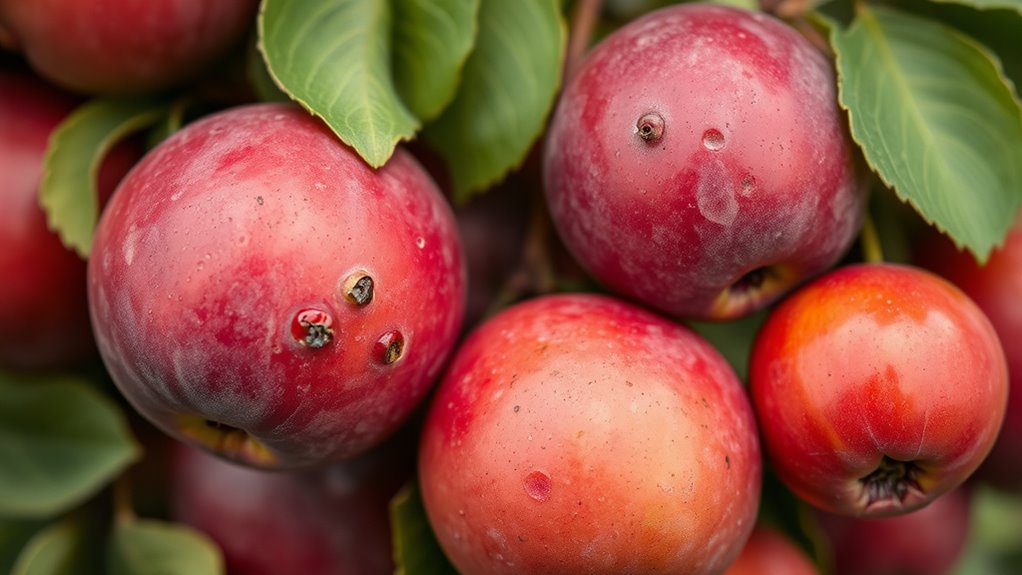
Several environmental and cultural factors influence the development of shot-hole disease in stone fruits. Warm, wet conditions create ideal environments for the pathogen to infect leaves and young shoots. High humidity increases leaf moisture, facilitating spore germination and disease spread. Overcrowded trees with dense foliage reduce airflow, promoting prolonged leaf wetness. Poor sanitation, such as not removing fallen leaves or infected debris, allows pathogens to overwinter and re-infect new growth. Frequent irrigation or watering late in the day extends leaf wetness periods, raising infection risk. Additionally, stress from drought, nutrient deficiencies, or pruning can weaken the trees’ defenses, making them more vulnerable. Proper cultural practices can help manage these factors by optimizing conditions for healthy growth. Managing these factors by optimizing cultural practices helps reduce disease development and supports overall tree health.
Monitoring and Inspection Techniques
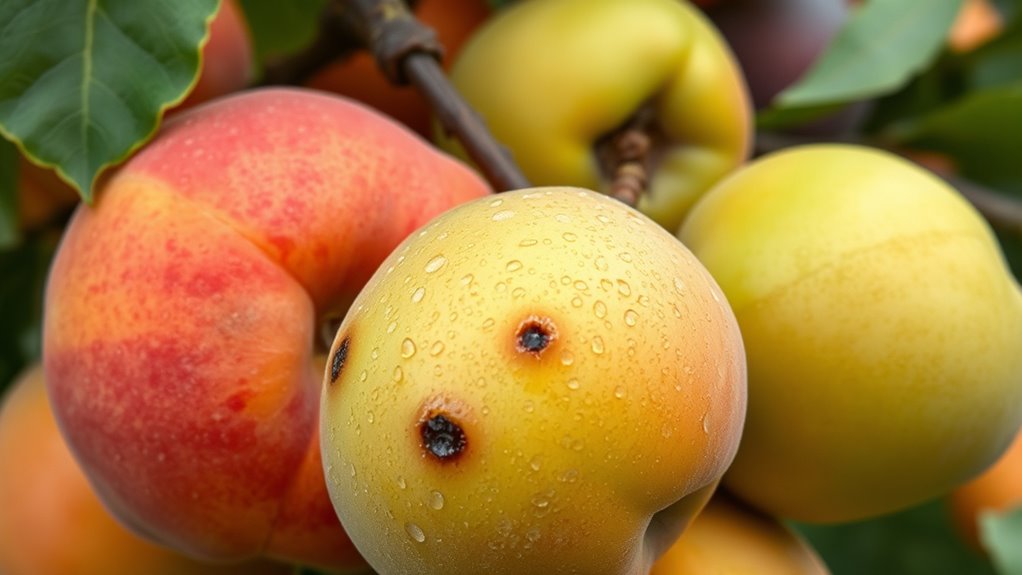
Effective monitoring and inspection are essential for managing shot-hole disease in stone fruits. Regularly examine your trees for early signs, such as small, sunken leaf spots or shot-hole-like lesions on fruit. Use a systematic approach, inspecting all sides of the branches and canopy. Keep detailed records of disease occurrences to identify patterns and high-risk areas. Early detection allows for prompt intervention, reducing disease spread.
Regular tree inspections enable early detection and effective control of shot-hole disease.
Key inspection tips include:
- Check new growth for initial symptoms
- Look for leaf defoliation or premature leaf drop
- Monitor fruit for spots and lesions
- Use magnification for detailed observation
Consistent monitoring helps you stay ahead of the disease, enabling timely treatment and minimizing crop damage.
Preventative Measures to Reduce Risk

Maintaining good orchard sanitation helps reduce the spread of shot-hole disease by removing infected debris and fallen leaves. Choosing resistant fruit varieties can notably lower your risk of infection. Implementing these practices early on will give your trees a stronger defense against the disease. Regular monitoring for early signs of infection is also essential for effective management exfoliation benefits.
Proper Orchard Sanitation
To reduce the risk of shot-hole disease, you need to prioritize proper orchard sanitation. Keep your orchard clean by removing fallen leaves, fruit, and debris that can harbor fungal spores. Regularly prune dead or diseased wood to improve air circulation and reduce humidity, which discourages pathogen development. Sanitize pruning tools after each use to prevent spreading infections. Additionally, avoid overcrowding trees, as dense canopies trap moisture and create favorable conditions for disease. Proper maintenance practices are essential for long-term disease management and overall orchard health.
- Remove and destroy infected plant material promptly
- Prune to improve airflow and sunlight penetration
- Sanitize tools regularly with disinfectant
- Manage orchard floor by cleaning debris and weeds
Selecting Resistant Varieties
Choosing disease-resistant varieties is a proactive step you can take to minimize shot-hole disease in your orchard. When selecting your stone fruit varieties, look for cultivars with documented resistance or tolerance to common fungal pathogens associated with shot-hole disease. These resistant varieties naturally have a stronger ability to withstand infection, reducing the need for chemical controls and management efforts. Consulting with local extension services or nursery specialists can help identify the best options suited to your climate and region. Keep in mind that even resistant varieties benefit from good cultural practices, such as proper pruning and sanitation. Additionally, understanding cultural intelligence can help in adopting tailored management strategies that fit your specific orchard environment. By choosing resistant cultivars, you decrease the overall disease pressure, helping you maintain healthier trees and better fruit quality throughout the season.
Organic and Chemical Treatment Options

When it comes to managing shot-hole disease in stone fruits, both organic and chemical options offer effective strategies. Organic treatments often include copper-based fungicides or biofungicides, which can help control the disease without synthetic chemicals. Chemical options, like specific fungicides, are usually more potent and provide faster results when applied correctly. Timing is essential; applying treatments early in the season or at signs of infection increases their effectiveness.
Keep in mind:
- Always follow label instructions for application and timing.
- Rotate fungicides to prevent resistance buildup.
- Combine treatments with good cultural practices for best results.
- Regular monitoring ensures timely intervention.
Proper Pruning and Cultural Practices
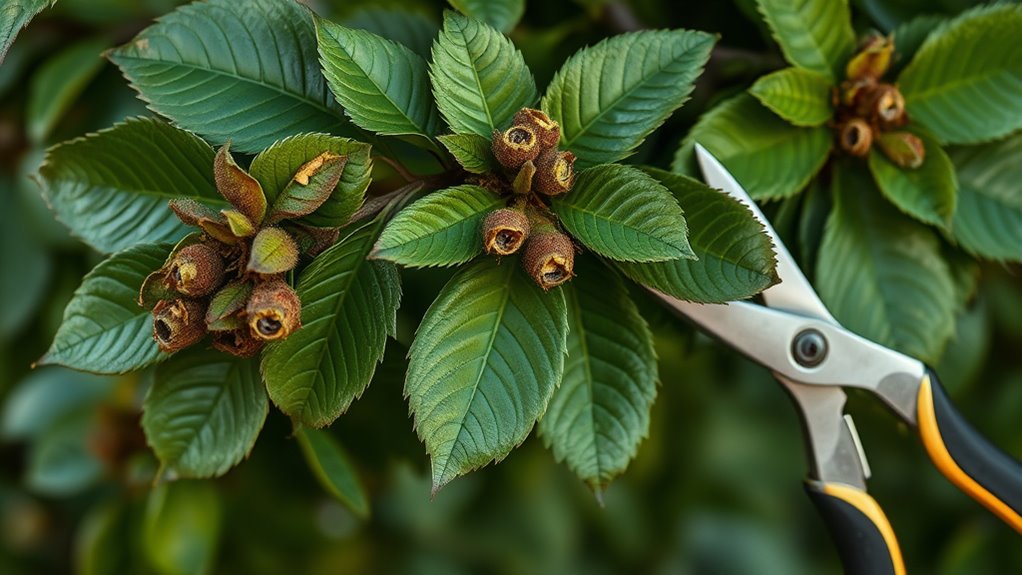
Timing your pruning correctly helps minimize stress on your trees and reduces disease spread. You should prune when the tree is dormant or just before new growth begins for the best results. Keeping your tree healthy through proper pruning helps it resist shot-hole disease and other issues.
Pruning Timing Tips
Pruning your stone fruit trees at the right time is essential for maintaining healthy growth and preventing disease. Timing influences how well the tree heals and reduces vulnerability to infections like shot-hole disease. Ideally, prune during late winter or early spring before bud break, when the tree is dormant. Avoid heavy pruning in late summer or fall, which can stimulate new growth that’s susceptible to disease. Additionally, monitoring for signs of AI-related vulnerabilities can help inform safer pruning practices. AI vulnerabilities and other risks should be considered when planning your orchard management.
- Prune before bud break for best results
- Remove dead or diseased wood promptly
- Avoid pruning during wet weather to prevent spread
- Thin out crowded branches to improve airflow
Following these timing tips helps you minimize disease risk and promotes strong, healthy growth. Proper pruning at the right time is a key part of your overall cultural practices.
Maintain Tree Health
Proper pruning and cultural practices play a vital role in maintaining the overall health of your stone fruit trees. Regularly remove dead, diseased, or crossing branches to improve air circulation and sunlight penetration. This reduces moisture buildup, which can foster disease development like shot-hole. Keep your trees balanced; avoid over-pruning, which stresses the plant, or under-pruning, which hampers airflow. Implement proper irrigation—deep watering during dry periods promotes strong growth without waterlogging roots. Fertilize appropriately based on soil tests to guarantee your trees receive essential nutrients. Mulch around the base to conserve moisture and suppress weeds. Consistent maintenance keeps your trees vigorous and resilient, making them less susceptible to diseases. Healthy trees recover faster and produce better fruit, supporting long-term orchard productivity. Regularly monitoring your trees with simple tools like BTU and CADR quick‑calculators can help identify and address issues early, ensuring optimal health.
Managing and Controlling Outbreaks
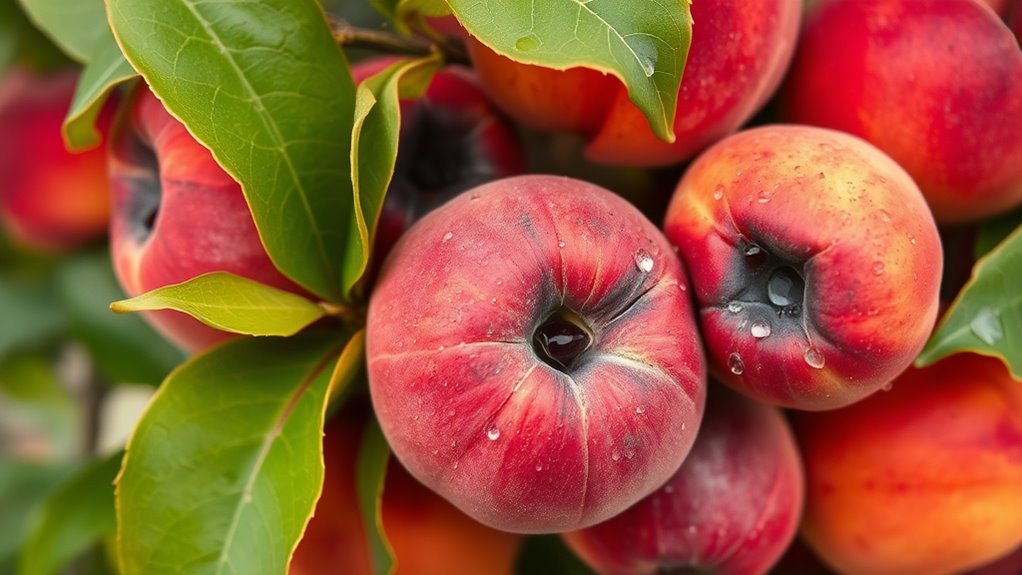
When a shot-hole disease outbreak occurs in your stone fruit trees, prompt and strategic action is essential to prevent widespread damage. Start by removing and destroying fallen leaves and infected twigs to reduce sources of the fungus. Applying targeted fungicides at the first signs of infection can help contain the outbreak. Regularly monitor your trees to catch new symptoms early. Keep your orchard well-pruned to improve air circulation, which limits fungal growth.
Promptly remove infected debris and apply fungicides early to control shot-hole disease in stone fruit trees.
- Use resistant varieties when planting new trees
- Follow a consistent fungicide schedule
- Clean and disinfect pruning tools after use
- Avoid overhead watering to reduce leaf wetness
Long-Term Strategies for Healthy Stone Fruit Trees
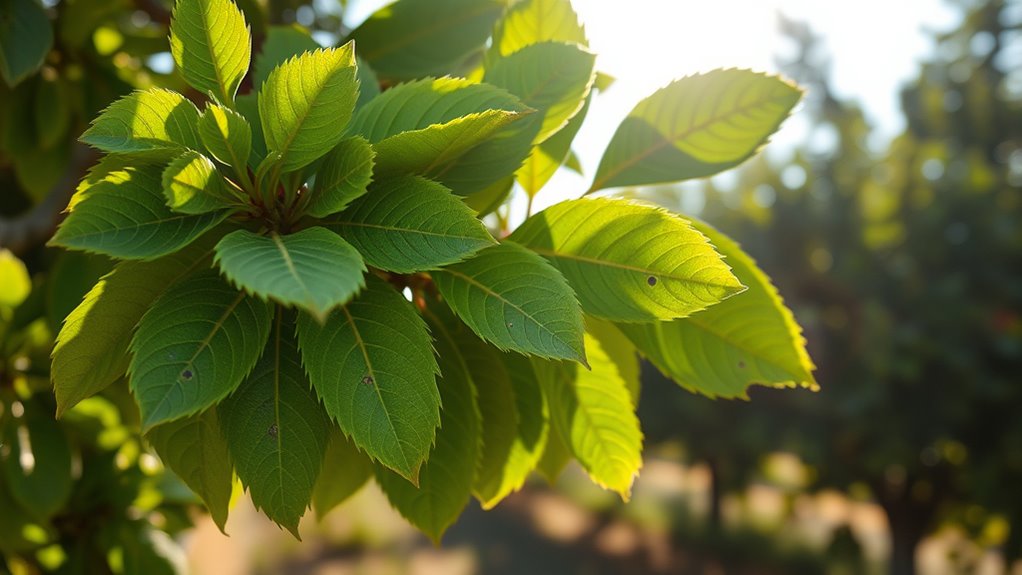
Implementing long-term strategies is key to maintaining healthy stone fruit trees and preventing future disease outbreaks. Start by selecting disease-resistant varieties suited to your climate, which naturally reduces vulnerability. Ensure proper pruning to improve air circulation and remove diseased or dead branches, lowering infection risk. Maintain a consistent fertilization schedule to promote strong growth and immune health. Regularly monitor your trees for early signs of disease or pests, enabling quick intervention. Practice crop rotation and avoid planting stone fruits in the same spot year after year to reduce pathogen buildup. Keep your orchard clean by removing fallen leaves and fruit that can harbor pathogens. These proactive steps will help your trees stay vigorous, resilient, and better equipped to fend off shot-hole disease long-term.
Frequently Asked Questions
How Does Shot-Hole Disease Affect Fruit Quality and Yield?
Shot-hole disease reduces fruit quality and yield by causing premature fruit drop and deformities. You’ll notice small, round holes on the fruit surface, leading to increased vulnerability to infections and pests. As the disease progresses, it weakens the fruit, making it less appealing and marketable. If left untreated, it can profoundly lower your harvest, forcing you to deal with reduced productivity and potential economic losses.
Are Certain Stone Fruit Varieties More Resistant to Shot-Hole Disease?
You’ll find that some stone fruit varieties are more resistant to shot-hole disease, making your management easier. For example, resistant varieties like certain peach and plum cultivars have tougher leaf tissues, limiting fungal infection. While no variety is completely immune, choosing resistant types can markedly reduce outbreaks. This means you spend less time on treatments and more on enjoying healthy, vibrant fruit. Resistance varies, so consult local experts for the best options in your area.
Can Weather Conditions Predict the Likelihood of Disease Outbreaks?
Weather conditions can help predict shot-hole disease outbreaks. Warm, humid weather creates ideal conditions for the bacteria to spread and infect trees. If you notice a period of rain followed by humidity and moderate temperatures, be alert for symptoms. Monitoring weather forecasts allows you to anticipate potential problems, enabling you to take preventative measures like applying fungicides early and reducing leaf wetness to minimize disease risk effectively.
What Are the Signs of Secondary Infections Following Shot-Hole Disease?
Ever wonder what happens if shot-hole disease isn’t managed? Secondary infections often set in, showing up as dark, sunken lesions or cankers on the fruit, leaves, or branches. You might notice increased bacterial or fungal growth, which worsens the damage. These secondary invaders can cause fruit rot or branch dieback, making your crop more vulnerable. Keep an eye out for these signs to catch issues early and protect your orchard effectively.
How Long Does It Take for Treatments to Show Results?
Treatments for shot-hole disease typically start showing results within one to two weeks. You should notice reduced leaf spotting and fewer new lesions as the fungicides or other treatments take effect. Keep in mind, consistent application as recommended and proper sanitation are essential for effectiveness. If you don’t see improvements after this period, consider adjusting your treatment plan or consulting an expert to prevent further spread.
Conclusion
By staying vigilant and practicing proper management, you can effectively prevent and control shot‑hole disease in your stone fruits. Regular monitoring, timely treatments, and good cultural practices are key to healthy trees. Are you ready to take the necessary steps to protect your orchard? With consistent effort and attention, you’ll keep your fruit trees thriving and free from this damaging disease. Don’t wait—your trees’ health depends on your proactive approach today.



